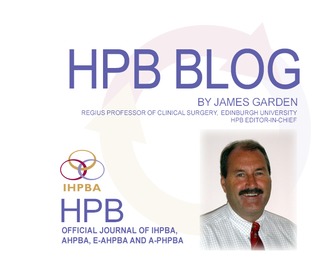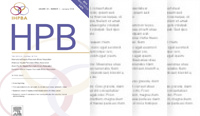International Hepato-Pancreato-Biliary Association
HPB October Blog 2018

As I wind down as Editor-in-Chief, it is really pleasing to sit back and admire the quality of articles now being published in HPB. This is not just down to the editorial team alone but credit has to be given to those authors who have supported our journey in trying to provide quality educational focus for our international and regional associations. This October issue achieves this in spades and demonstrates the depth of evidence-based material now gracing the pages of the journal. Just take a look at the three editorial highlights to feel the quality and to see what is hot in our specialty! This issue kicks off with four really excellent reviews. Solaini and colleagues from Amsterdam focus on aggressive resectional surgery for locally invasive pancreatic cancer whereas Levy and his Canadian colleagues suggest that intra-arterial therapies in treating challenging colorectal liver metastases show promise but, as is the case for aggressive pancreatic surgery, there is a need for much better evidence and guidance that will assist the surgeon in improving patient selection for aggressive therapies.
We have been delighted over recent years to observe a progressive increase in accepted articles from Asia. In this issue, Man and his colleguees from Bengbu and Xiao and colleagues from Nanchang underline this very trend. They highlight the importance of nutritional status and its impact on outcome following HCC resection while the latter group emphasise the need to balance the potential additional risk of operative complications against the likely conservation of pancreatic function with central resections.
This October issue is remarkable for its wide range of international single centre contributions many of which may well impact on global surgical practice in the future. Staufer et al show the effect on outcomes resulting in a change in organ allocation in Austria while Clanton et al report an experience from Seattle which suggests that imaging overestimates vascular involvement in patients presenting with locally invasive pancreatic cancer. Noel and colleagues from Stockholm produce a different twist on an old chestnut and question why any surgeon would delay cholecystectomy in managing patients presenting with mild gallstone pancreatitis. If HPB surgeons do not promote best practice for gallstone disease all is lost. There are two studies that seek to provide insight in predicting outcome for the more uncommon intrahepatic cholangiocarcinoma. Kobayashi et al also report a favourable Japanese experience of parenchymal sparing resection for HCC while Wu and his Auckland team point out that liver transplantation trumps all other treatment options, when indicated and possible.
You will be sorry if you do not read the October issue right to the end. Take a look at the paper from Andrianello and colleagues from Verona. Just when you thought you knew exactly what contributed to the development of pancreatic fistula, this group suggests that polyester sutures provide added protection against this very complication! Look at your own data – challenge the hypothesis and get back to us with a further quality study!
James Garden
Corporate Partners
If you are interested in becoming a Corporate Partner of the IHBPA please contact industry@ihpba.org
Find out more


